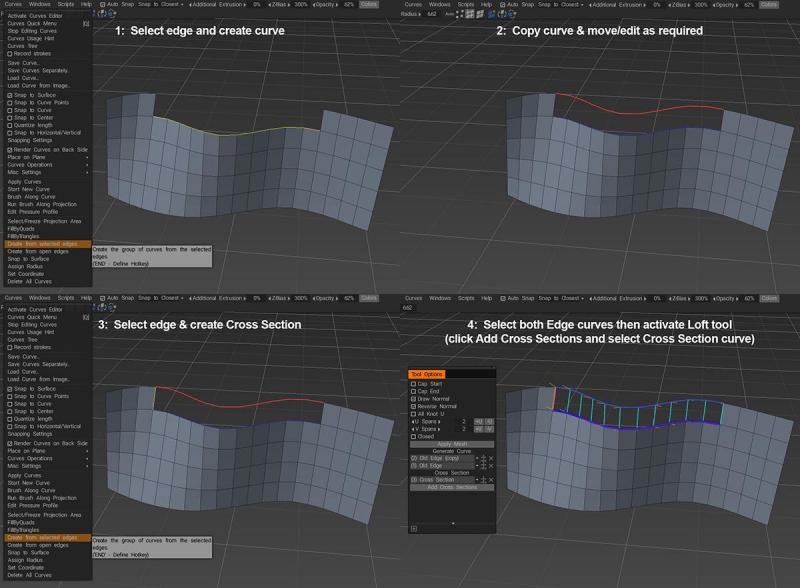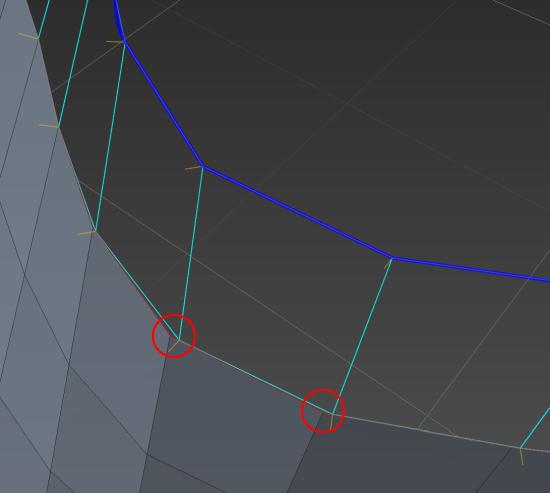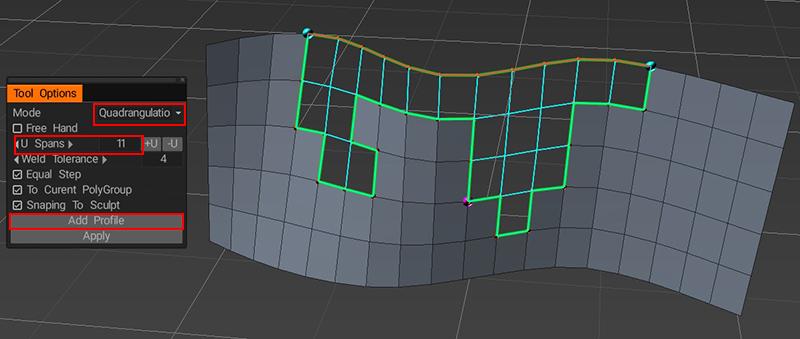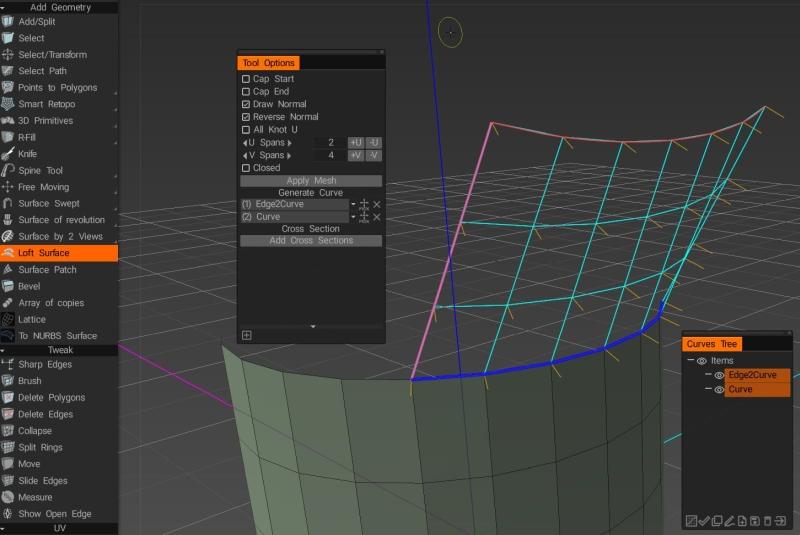Κατάφερα να καταλάβω τη διαδικασία σύνδεσης με την υπάρχουσα γεωμετρία κατά τη γεφύρωση μεταξύ δύο άκρων. (έγινε λίγο πιο ξεκάθαρο μόλις συνειδητοποίησα ότι το επιλεγμένο άκρο που φαίνεται κάλυπτε την τρίτη καμπύλη που χρησιμοποιήθηκε στη λειτουργία της σοφίτας).

Αξίζει να σημειωθεί ότι η σειρά με την οποία εμφανίζονται οι δύο καμπύλες προφίλ στο παράθυρο Επιλογές εργαλείου μπορεί να επηρεάσει το πλέγμα που προκύπτει. Ο αριθμός των κόμβων στην πρώτη καμπύλη της λίστας (σε συνδυασμό με την τιμή που έχει οριστεί για το U Spans) καθορίζει τον αριθμό των πολυγώνων που δημιουργούνται και τη σειρά με την οποία εμφανίζονται οι καμπύλες, προσδιορίζοντας την κατεύθυνση των κανονικών κορυφών στο πλέγμα που προκύπτει. Επιπλέον, ας υποθέσουμε ότι η καμπύλη που ορίζει την άκρη που σκοπεύετε να δημιουργήσετε εμφανίζεται πρώτη στη λίστα. Σε αυτήν την περίπτωση, το αποτέλεσμα όταν πατήσετε Εφαρμογή μπορεί να μην ευθυγραμμίζεται σωστά με το υπάρχον πλέγμα σας (χωρίς να υπεισέλθω σε πολλές λεπτομέρειες, φαίνεται να έχει να κάνει με τον τρόπο με τον οποίο οι κανονικές κορυφές επηρεάζουν τον τρόπο με τον οποίο το 3D Coat δημιουργεί την ψηλή επιφάνεια).

Η προσθήκη της καμπύλης διατομής που δημιουργήθηκε στο Βήμα 3 φαίνεται να επιλύει το πρόβλημα ανεξάρτητα από τη σειρά στις καμπύλες προφίλ που αναφέρονται, ωστόσο, μερικές φορές μπορεί να αναστρέψει τις κανονικές κορυφές του προκύπτοντος πλέγματος, επομένως είναι καλή ιδέα να ενεργοποιήσετε την επιλογή Σχεδίαση Κανονικής και στη συνέχεια να μπορεί να αλλάξει τη ρύθμιση Reverse Normal εάν χρειάζεται.
Όπως είπα, δεν είμαι εξοικειωμένος με το εργαλείο Loft, αλλά αυτό φαίνεται σαν ένας αρκετά αξιόπιστος τρόπος για να ανακτήσετε το επιθυμητό αποτέλεσμα. Ωστόσο, προτιμώ το εργαλείο Smart Retopo , το οποίο μπορεί να επιτύχει παρόμοια αποτελέσματα χρησιμοποιώντας λιγότερες καμπύλες.
Το μόνο που χρειάζεται να κάνετε είναι να δημιουργήσετε μια καμπύλη για την άκρη που θέλετε να δημιουργήσετε και στη συνέχεια να ενεργοποιήσετε το εργαλείο Smart Retopo , να ορίσετε τη λειτουργία σε Τετραγωνοποίηση , να πατήσετε το κουμπί Προσθήκη προφίλ και να επιλέξετε την καμπύλη και, στη συνέχεια, να ορίσετε τον απαιτούμενο αριθμό U Spans . Ίσως χρειαστεί να τροποποιήσετε γρήγορα τη θέση κάθε άκρου της καμπύλης για να βεβαιωθείτε ότι θα κουμπώσει στις σωστές κορυφές στο υπάρχον πλέγμα, αλλά μόλις τοποθετηθούν σωστά και τα δύο άκρα, θα δείτε κάτι σαν αυτό…

(Στην αρχή, θα πρέπει να βλέπετε μόνο το πράσινο περίγραμμα, αλλά εάν πατήσετε το κουμπί Εφαρμογή, θα κάνει προεπισκόπηση των αποτελεσμάτων και εάν πατήσετε το κουμπί Εφαρμογή για δεύτερη φορά θα δημιουργήσει το πλέγμα).
Όπως μπορείτε να δείτε, το εργαλείο Smart Retopo μπορεί να γεμίσει ακανόνιστα σχήματα, τα οποία θα μπορούσαν ενδεχομένως να είναι προβληματικά ή/και χρονοβόρα χρησιμοποιώντας το εργαλείο Loft, αλλά θα συνιστούσα να μάθετε πώς να χρησιμοποιείτε και τα δύο. Όπως συμβαίνει με τα περισσότερα πράγματα στο 3DCoat, υπάρχουν πολλοί τρόποι για να επιτύχετε τα ίδια αποτελέσματα και ποια μέθοδος λειτουργεί καλύτερα εξαρτάται σε μεγάλο βαθμό από τις προσωπικές σας προτιμήσεις και τη συνολική ροή εργασίας. Ας ελπίσουμε ότι οι παραπάνω πληροφορίες θα σας βοηθήσουν να προσδιορίσετε ποια προσέγγιση λειτουργεί καλύτερα για εσάς. ![]()
Ανακεφαλαιώνοντας, απλώς επιλέξτε την άκρη που θέλετε να τοποθετήσετε στη σοφίτα και επιλέξτε Δημιουργία από επιλεγμένες άκρες από το μενού Καμπύλες και, στη συνέχεια, επιλέξτε τη νέα καμπύλη και την αρχική σας καμπύλη και ενεργοποιήστε το εργαλείο Loft Surface στον πίνακα Προσθήκη γεωμετρίας …

… στη συνέχεια, απλώς ρυθμίστε τα V Spans, ελέγξτε ότι τα κανονικά σας δείχνουν προς το σωστό τρόπο και πατήστε Εφαρμογή πλέγματος.
 Ελληνικά
Ελληνικά  English
English Українська
Українська Español
Español Deutsch
Deutsch Français
Français 日本語
日本語 Русский
Русский 한국어
한국어 Polski
Polski 中文 (中国)
中文 (中国) Português
Português Italiano
Italiano Suomi
Suomi Svenska
Svenska 中文 (台灣)
中文 (台灣) Dansk
Dansk Slovenčina
Slovenčina Türkçe
Türkçe Nederlands
Nederlands Magyar
Magyar ไทย
ไทย हिन्दी
हिन्दी Tiếng Việt
Tiếng Việt Lietuviškai
Lietuviškai Latviešu valoda
Latviešu valoda Eesti
Eesti Čeština
Čeština Română
Română Norsk Bokmål
Norsk Bokmål